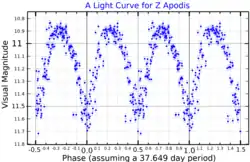Z Apodis
Z Apodis (Z Aps) is a variable star in the constellation of Apus. It has an apparent visual magnitude which varies between 10.8 and 12.8,[3] over a period of 39.37 days.[3] Although described in the General Catalogue of Variable Stars as a cataclysmic variable star, it appears that it is a pulsating variable star,[4] and has been classed as an RV Tauri variable star, type RVa.[3] Other sources classify it is a type II (W Virginis) Cepheid.[7]
| Observation data Epoch J2000.0 Equinox J2000.0 (ICRS) | |
|---|---|
| Constellation | Apus |
| Right ascension | 14h 06m 54.82s[2] |
| Declination | −71° 22′ 16.7″[2] |
| Apparent magnitude (V) | 10.8 to 12.0[3] |
| Characteristics | |
| U−B color index | +0.5 - +1.5[4] |
| B−V color index | +1.5 - +1.75[4] |
| Variable type | RV Tau?[3] |
| Astrometry | |
| Proper motion (μ) | RA: −3.841[2] mas/yr Dec.: −1.604[2] mas/yr |
| Parallax (π) | 0.3135 ± 0.0131 mas[2] |
| Distance | 10,400 ± 400 ly (3,200 ± 100 pc) |
| Details | |
| Mass | 3.2[5] M☉ |
| Radius | 27.6[2] R☉ |
| Luminosity | 405[2] L☉ |
| Surface gravity (log g) | 2.12[2] cgs |
| Temperature | 4,579[2] K |
| Metallicity [Fe/H] | −0.76[5] dex |
| Age | 11[6] Gyr |
| Other designations | |
| Database references | |
| SIMBAD | data |
References
- "ASAS-SN Variable Stars Database". ASAS-SN Variable Stars Database. ASAS-SN. Retrieved 6 January 2022.
- Vallenari, A.; et al. (Gaia collaboration) (2023). "Gaia Data Release 3. Summary of the content and survey properties". Astronomy and Astrophysics. 674: A1. arXiv:2208.00211. Bibcode:2023A&A...674A...1G. doi:10.1051/0004-6361/202243940. S2CID 244398875. Gaia DR3 record for this source at VizieR.
- Watson, Christopher (4 January 2010). "Z Apodis". The International Variable Star Index. American Association of Variable Star Observers. Retrieved 20 Nov 2022.
- Marino, B. F.; Walker, W. S. G. (1991). "Z Apodis is a Pulsating - not a Cataclysmic - Variable Star". Information Bulletin on Variable Stars. 3664: 1. Bibcode:1991IBVS.3664....1M.
- Anders, F.; Khalatyan, A.; Queiroz, A. B. A.; Chiappini, C.; Ardevol, J.; Casamiquela, L.; Figueras, F.; Jimenez-Arranz, O.; Jordi, C.; Monguio, M.; Romero-Gomez, M.; Altamirano, D.; Antoja, T.; Assaad, R.; Cantat-Gaudin, T.; Castro-Ginard, A.; Enke, H.; Girardi, L.; Guiglion, G.; Khan, S.; Luri, X.; Miglio, A.; Minchev, I.; Ramos, P.; Santiago, B. X.; Steinmetz, M. (2022). "VizieR Online Data Catalog: StarHorse2, Gaia EDR3 photo-astrometric distances (Anders+, 2022)". Vizier Online Data Catalog. Bibcode:2022yCat.1354....0A.
- Fouesneau, M.; Andrae, R.; Dharmawardena, T.; Rybizki, J.; Bailer-Jones, C. A. L.; Demleitner, M. (2022). "Astrophysical parameters from Gaia DR2, 2MASS, and AllWISE". Astronomy and Astrophysics. 662: A125. arXiv:2201.03252. Bibcode:2022A&A...662A.125F. doi:10.1051/0004-6361/202141828. S2CID 245837778.
- Ripepi, V.; Molinaro, R.; Musella, I.; Marconi, M.; Leccia, S.; Eyer, L. (2019). "Reclassification of Cepheids in the Gaia Data Release 2. Period-luminosity and period-Wesenheit relations in the Gaia passbands". Astronomy and Astrophysics. 625: 625. arXiv:1810.10486. Bibcode:2019A&A...625A..14R. doi:10.1051/0004-6361/201834506. S2CID 119338608.
This article is issued from Wikipedia. The text is licensed under Creative Commons - Attribution - Sharealike. Additional terms may apply for the media files.
